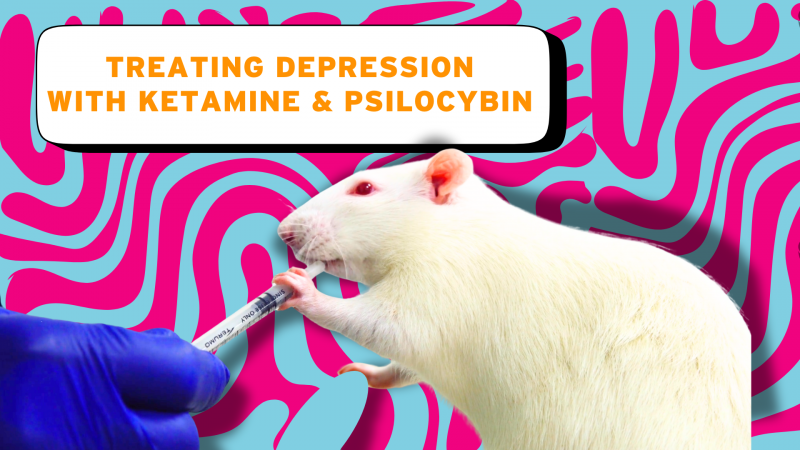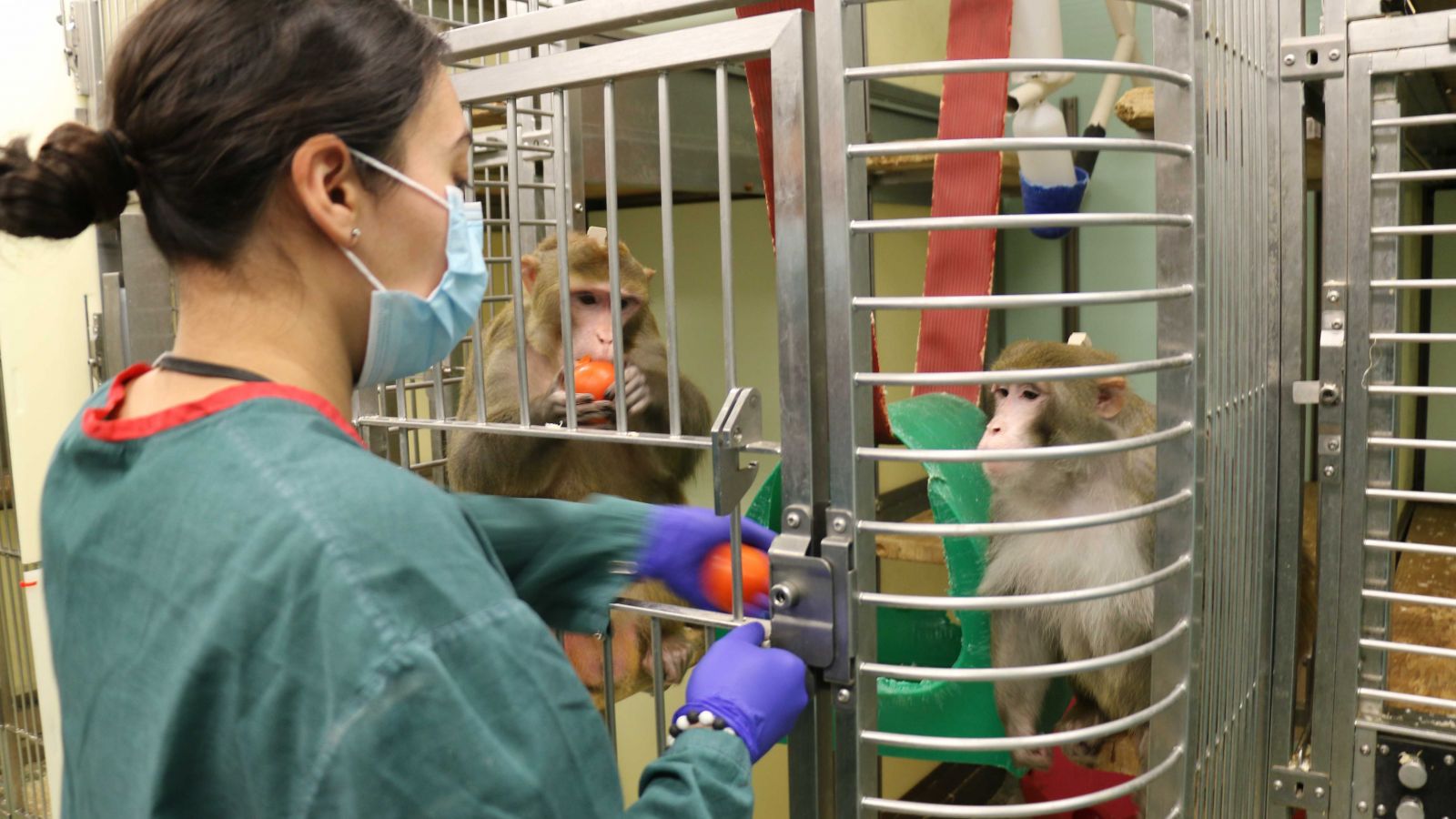
On this page
- Which monkeys are used in scientific research?
- Why are monkeys used in research?
- Why do some monkeys have cranial implants?
- What types of research are monkeys used in?
- Areas of research that have relied on monkeys
Which monkeys are used in scientific research?
The most commonly used monkeys in medical research are: Rhesus macaques (Macaca mulatta); Cynomolgus macaques (Macaca fascicularis); and Common Marmosets (Callithrix jacchus).
The order of primates can be broken down into three groups: apes; Old-World monkeys; and New-World monkeys. Macaques belong to the Old-World monkeys and are native to South and Southeast Asia. Marmosets are New-World monkeys, native to South America. Although the great apes (Orangutans, Chimpanzees, Bonobos, Gorillas) are our closest relatives, using a great ape in any regulated procedure is banned under UK legislation.
The next-closest ape species to humans are the Old-World monkeys. Humans share around 94% of their genetic code with macaques, and 91.7% with marmosets. This is compared to 85% genetic similarity between humans and rodents, making primates both physically and genetically the most useful comparison to humans in the animal kingdom.
Why are monkeys used in research?
Each year, around 2,000 – 3,000 primates are involved in experiments in Great Britain. This makes up 0.1% of the animals used in research.
Because Old-World monkeys are anatomically, physiologically, and genetically so similar to humans, they can be useful models for human disease. Macaques and marmosets have similar brains, muscle structure and reproductive and immune systems to humans. This means research with monkeys can provide results which are more relevant to humans compared to information obtained from mice or rats.
Roger Lemon, retired Professor of Neurophysiology at the Institute of Neurology, UCL, goes even further and says:
“I am absolutely certain that our knowledge of the human motor system would be very poor indeed without the wealth of neuroanatomical and neurophysiological studies carried out in monkeys.”
Monkeys are complex animals with complex needs, for example needing larger enclosures, additional enrichment, and social housing. Monkeys are very intelligent and sensitive animals, which is why they are protected by stricter regulations than other species and can only be used when it is absolutely necessary.
Why do some research monkeys have cranial implants?
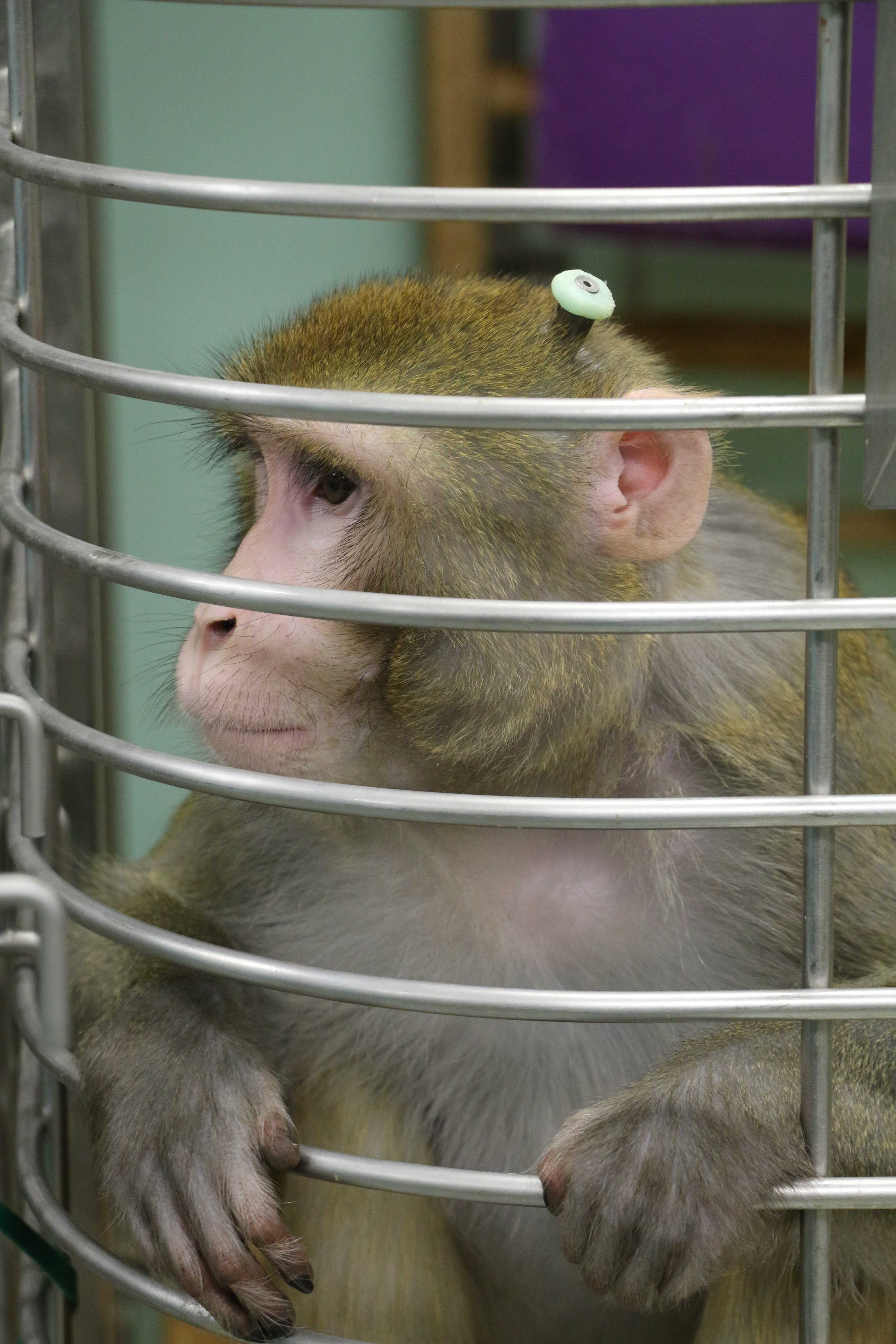 Cranial implants, sometimes known as head posts, are required for monkeys which are used in some neurological research. The implants serve a dual purpose, providing easy access to the brain if needed, and providing a safe and low-stress method of stabilising the position of the monkey's head.
Cranial implants, sometimes known as head posts, are required for monkeys which are used in some neurological research. The implants serve a dual purpose, providing easy access to the brain if needed, and providing a safe and low-stress method of stabilising the position of the monkey's head.
Cranial implants or head posts are implanted into the monkey's skull whilst the animal is under anaesthetic. Implants must be monitored daily to ensure that wound healing is not impaired and no infection has arisen. Surgical aftercare such as pain relief is always given when needed.
Where do research monkeys come from?
In Great Britain, it is prohibited to conduct experiments on wild-caught monkeys due to the impact that capture and subsequent experiments have on their wellbeing, as well as the increased risk of disease transmission.
As a result of this, all monkeys involved in experimental procedures in Great Britain are either F1 generation (captive offspring of wild-caught individuals) or F2+ (offspring of captive individuals). Where possible, F2+ generation individuals are used instead of F1 individuals. You can see the numbers of F1 and F2+ individuals used in animal research in the Statistics of scientific procedures on living animals, Great Britain (Section 3.1.3).
A key source of cynomolgus macaques for research is breeding centres in Asia and Africa, including colonies in Mauritius, where macaques are non-native and are considered an invasive species and agricultural pest. Macaques that would otherwise be culled to control the population are bred to produce offspring that can be used in research.
In Great Britain, there are several establishments which are licensed to breed macaques solely for research purposes, for example, the Medical Research Council’s Centre for Macaques (CfM).
How are the monkeys looked after?
Animal welfare is a legal and ethical responsibility for everyone who works with research animals. In the UK, lab animals are cared for by animal technicians who have undergone extensive training on the care and welfare of animals in a laboratory setting.
Within the lab, senior animal technicians and Named Animal Care and Welfare Officers (NACWOs) are responsible for each animal’s health and wellbeing and are not involved in the research. Animal technicians spend every day with the animals observing them, ensuring they are experiencing as little suffering as possible, and enriching their lives with activities that mimic the natural behaviours that would be displayed in the wild, for example foraging.
All research establishments in the UK must have a veterinarian on call 24 hours a day in case of emergencies.
Housing
Primates are highly intelligent and social animals, and require large enclosures that allow individuals to walk, climb, swing and leap. Housing is designed to suit the unique biology of each species. For example, wild marmosets spend most of their time in trees and so their housing is made with this in mind: complex vertical structures like bridges, swings and perches above human head height are key to ensuring that marmosets can express their natural behaviours. To learn more about marmoset housing, click here.
Macaques, however, use floor space more, so ground-based structures are important as well as vertical spaces. To learn more about macaque housing, click here.
Both macaques and marmosets are highly social, living in multi-male, multi-female groups in the wild. To allow for natural social interactions, macaques are housed in pairs or social groups, and marmosets are housed in family groups. Animals may be isolated under rare circumstances, for example, if they are recovering from an illness or surgery and need to be quarantined or if being in a social group poses a danger to them.
Enrichment
As well as ample space, primates need a complex and stimulating environment. In captive settings such as zoos and laboratories, these needs are met through enrichment activities. Enrichment includes anything that stimulates the animals psychologically or through physical activity. The best enrichment activities are based around natural behaviours that the animals would exhibit in the wild and they are usually centred around most animals’ favourite activity; foraging for food.
Enrichment can also be structural (e.g. swings, climbing apparatus and water tanks), food-related (e.g. food puzzles and foraging) or other sensory stimuli (e.g. smells and sounds).
A prime example of enrichment for monkeys is spreading food, such as grains or dried fruit, around the home cage. (see video). This encourages the monkeys’ natural foraging behaviour and keeps them occupied for long periods of time.
Learn more about the enrichment used for marmosets on the University of Stirling’s marmoset care website.
Learn more about the enrichment used for macaques on the NC3Rs macaque website or head to the macaque holding room 1 of the University of Oxford lab tour to find out more about enrichment. Visit the food preparation room to find out more about how food is prepared for macaques.
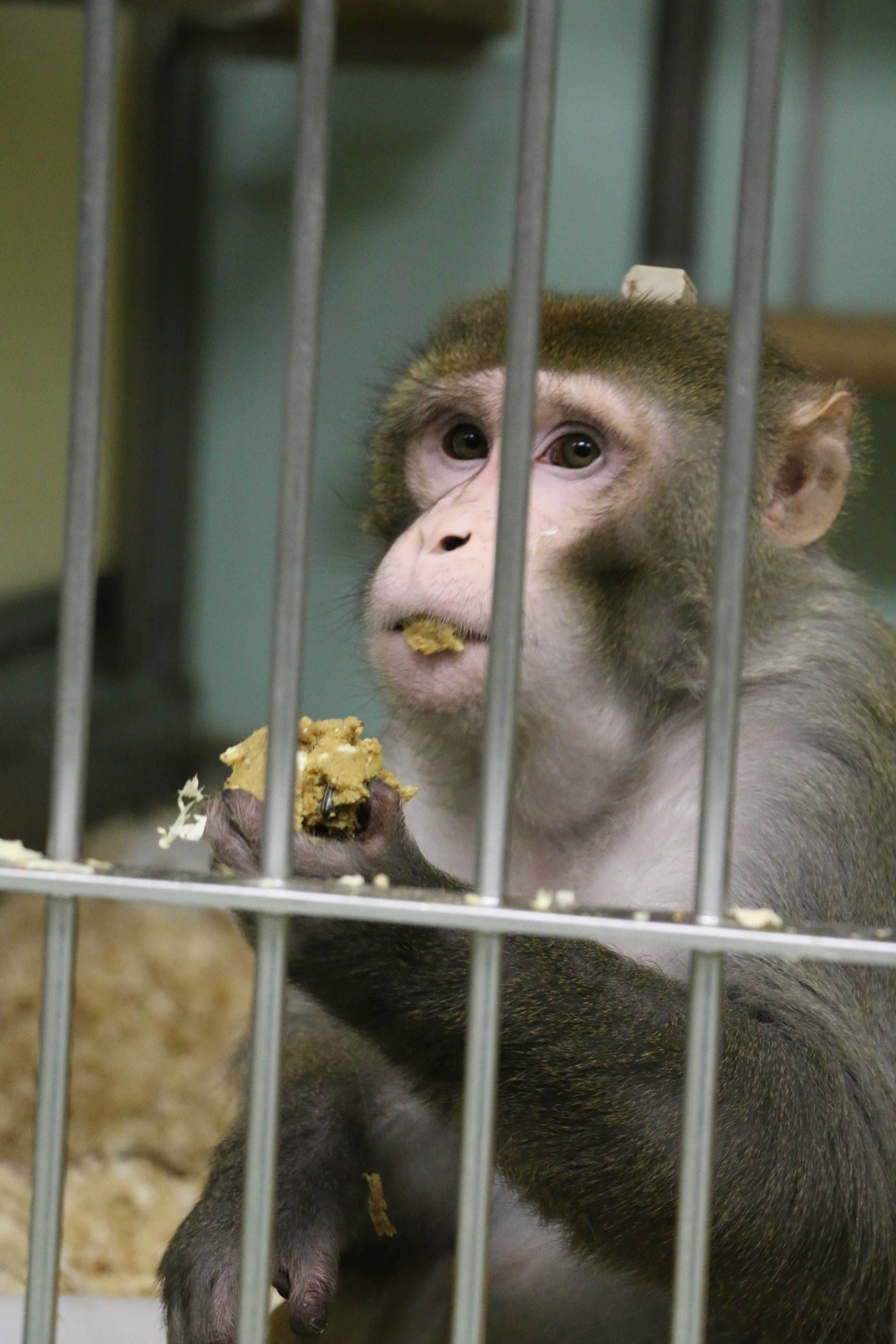
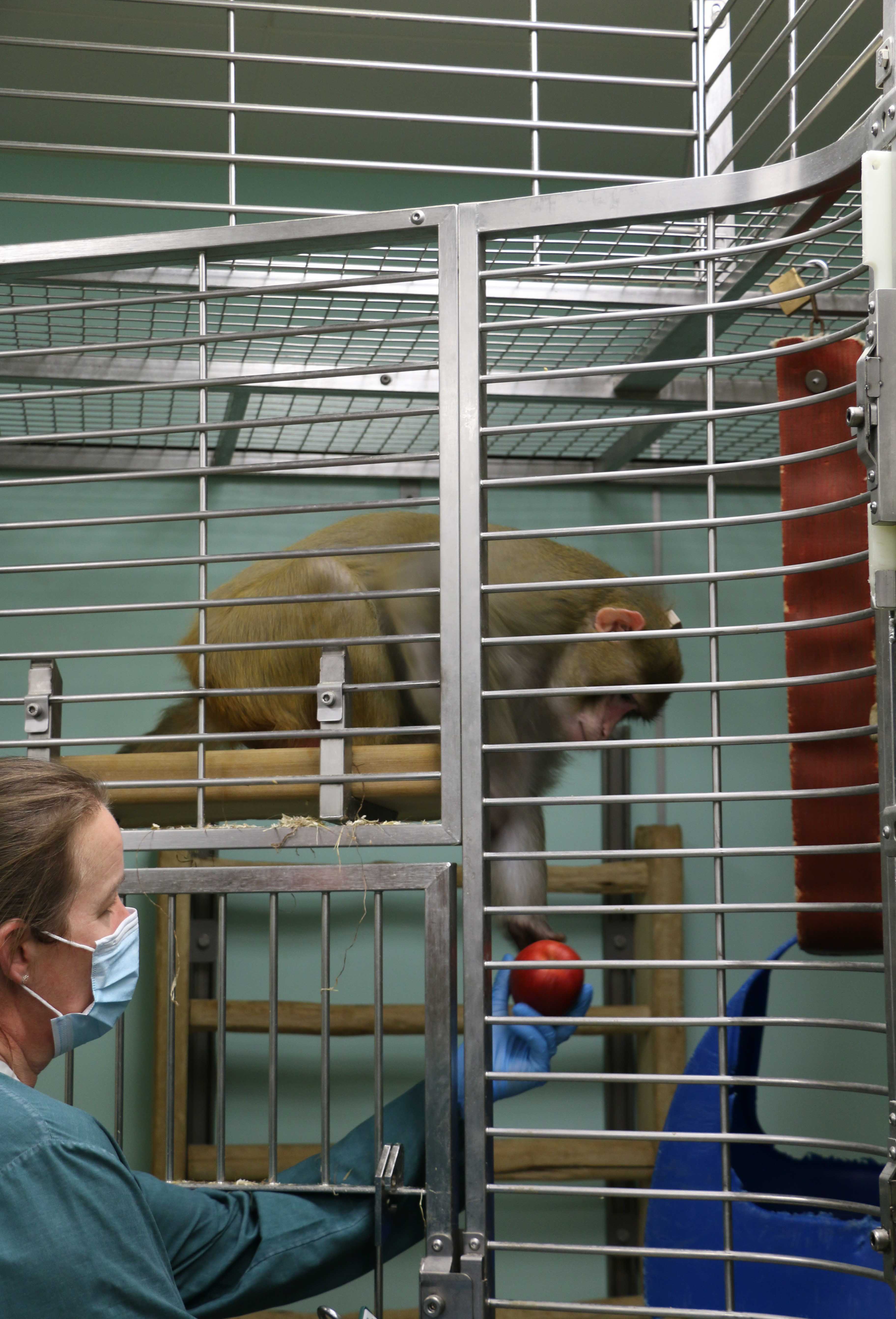
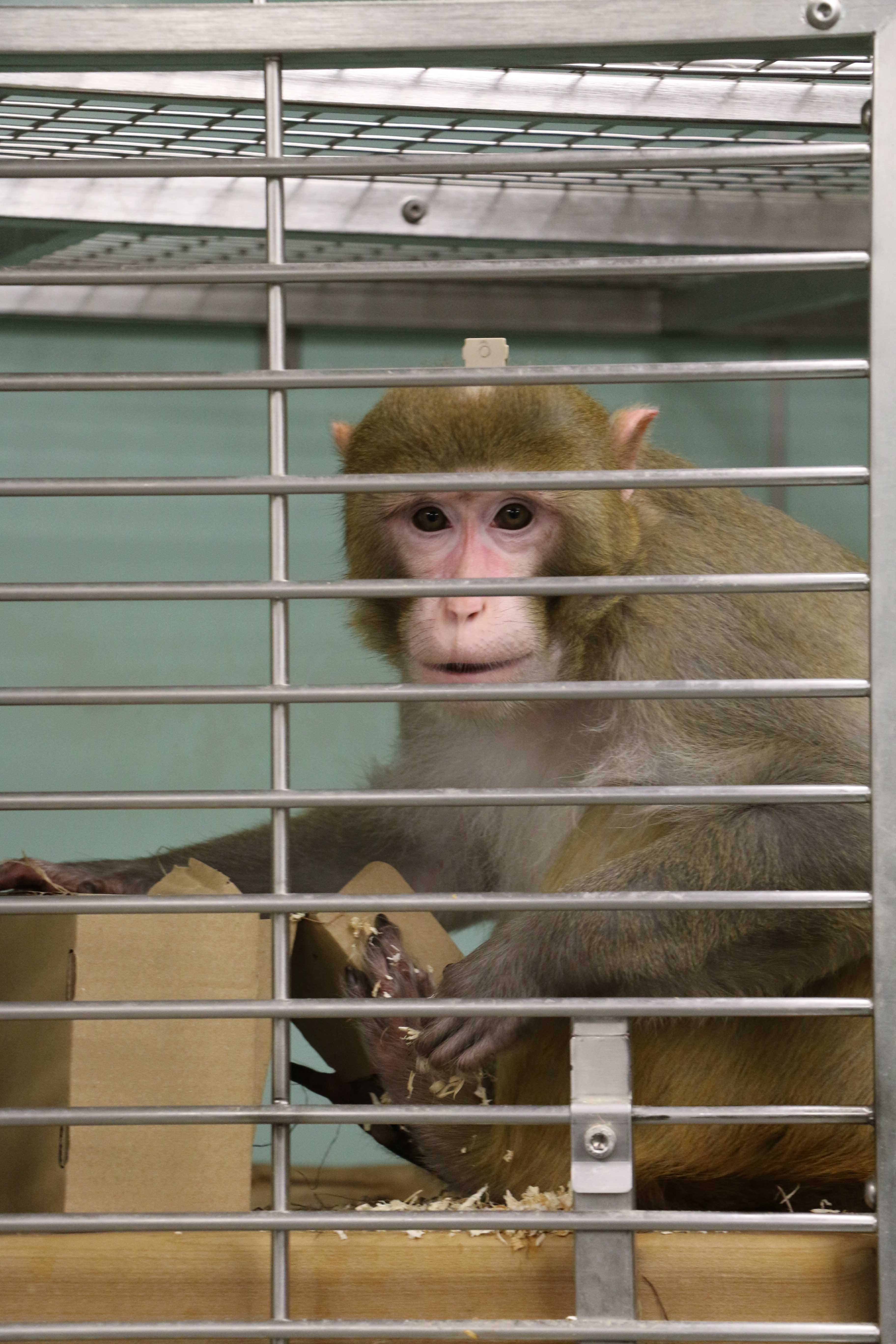
Training
In order to minimise the stress caused by captivity and research procedures, monkeys need to have a good relationship with their keepers. One of the ways that this is achieved is through positive reinforcement training. Training helps to reduce stress by putting the ball in the animal’s court. By rewarding desired behaviours, the animal learns to associate those behaviours with rewards, and is therefore more motivated to complete those tasks.
“We are finding that these monkeys can learn these tasks very quickly within their natural environment. It’s sort of like enrichment. It’s an interesting, fun game for them to play,” explains Professor Andrew Jackson, of Newcastle University.
Training also removes the need for some procedures to be performed. For example, taking blood used to require the animal to be anaesthetised, but now animals are trained to present their arms or legs for injections (see video). This is much less stressful for the individual animal and the animal carers.
Prof Jackson describes how this is approached at Newcastle University: “We want to see how much of the training we can actually do within the animals’ natural environment, so within the home cage where the monkeys live. We have developed a system that we can attach to the front of the cage, and the animals are free to come into this system and perform a simple task.”
Check out the training pages of the NC3Rs website for more information about training research animals.
Head to the Main Corridor Exit of the University of Oxford lab tour to hear more about how they train macaques for experiments.
Learn more about training animals to move to desired locations at the MRC Centre for macaques.
The future of research in monkeys
The use of monkeys in research remains controversial and has been the subject of vigorous campaigning by animal rights groups in the past. Many independent and expert enquiries such as the Weatherall Report have concluded that there is a strong case for using monkeys to advance scientific and medical knowledge and to assess the safety of new medicines. The use of monkeys, like other animals, should only be undertaken when there is no alternative, and should be subject to careful regulation.
Most research monkeys are macaques or marmosets. They are used in relatively small numbers (they make up around 0.1% of research animals) but they have been important in many major medical advances, for example, the polio vaccine, life support systems for premature babies, and deep brain stimulation for Parkinson’s disease.
Currently, the main areas of primate study are infectious diseases to develop vaccines and treatments for HIV/AIDS and malaria. Monkeys are also used in neuroscience to better understand the brain and treat conditions ranging from Alzheimer’s disease to schizophrenia. They are important in research into reproduction, fertility and foetal development, and they are also used in the safety testing of new medicines and vaccines.
What the experts think
In 2017, the Scientific Committee on Health, Environmental and Emerging Risks (SCHEER) released an updated opinion on the use of primates in research. Here is what they said:
“The use of non-human primates remains necessary for certain types of research, but when their use is required to be determined on a case to case basis and only if no viable alternatives are available it is essential to adopt the highest standards of non-human primates housing and husbandry and to follow best practice in the conduct and refinement of scientific procedures.”
The topic of using monkeys was the subject of the Weatherall Report in 2007. At the time the government’s Chief Scientific Advisor, Sir David King FRS, said:
"Although rare, the use of primates in medical research and testing is invaluable, as an essential aspect of work which provides the best hope for breakthroughs in important areas such as neurodegenerative disorders and for aspects of immune and reproductive functions."
MRC press release responding to the Weatherall Report, June 2007.
"There is a strong scientific case for the carefully regulated use of non-human primates where there are no other means to address clearly defined questions of particular biological or medical importance."
Weatherall Report: The use of non-human primates in research, December 2006:
"Primates have been used in research aimed at understanding how complex brains work, as their neurological development and higher cognitive functions are very similar to humans … Animal [primate] disease models were also used for research on hepatitis C, and polio."
Nuffield Council on Bioethics, The ethics of research using animals, May 2005:
"... for certain experiments there are no alternatives to the use of non-human primates. Such experiments may be needed, for example, during the development of drugs and vaccines for prevention and cure of disease such as AIDS, TSE1, malaria, and influenza".
European Commission Scientific Steering Committee (SSC), The Need for Non-Human Primates in Biomedical Research, April 2002:
"Many significant advances in modern medicine have been based on research involving primates."
What types of research are monkeys used in?
Monkeys have been used to study many different areas of human and animal disease. They have been essential in research into neurological disorders such as Parkinson’s disease, reproductive disorders, understanding how vision works, and the development of vaccines.
Like humans, monkeys see in colour and have binocular vision, which is why they have been used to better understand how humans process visual information from the 3D environment.
Rhesus macaque monkeys were vital in the race to develop an effective vaccine against SARS-COV-2, the virus that causes COVID-19. Monkeys were used to identify the most promising candidates for vaccines and ensure that they were safe enough for human volunteers to take in the large-scale clinical trials that took place.
Marmoset monkeys are predominantly used for research into Parkinson’s disease. Since the accidental discovery of MPTP, a substance that destroys a part of the brain and causes the symptoms of Parkinson’s, MPTP is used to induce the symptoms of Parkinson’s in marmoset monkeys. This has helped scientists explore new treatments for Parkinson’s disease.
More examples of how monkeys are used in research are listed in our iBook: Primates in Medical Research.
Areas of research that have relied on monkeys
Alzheimer's disease
Like Parkinson’s, Alzheimer’s is a neurodegenerative disorder, meaning that it involves the progressive loss of nerve cells in the brain over time. In the case of Alzheimer’s, this is thought to be caused by the build-up of material called amyloid plaques around the nerve cells, and tangles of fibres within the cells, reducing their function and connectivity.
There are several animal models of Alzheimer’s disease, mostly rodents but also monkeys. Monkeys are essential in this research as drugs developed using only rodent models show a much lower efficacy when translated to human trials.
Monkeys have a shorter lifespan than the typical human. Most monkey species live for 20-25 years, although some can reach 40 and others only live to 12. Because monkeys have a shorter lifespan than humans, researchers can more easily investigate the process of brain ageing and how diseases progress over time.
More about primates in Alzheimer’s research
22/09/2017: Dr Mark Dallas Reddit Ask Me Anything
06/07/2018: Alzheimer’s Researchers win 2018 Brain Prize
26/05/2021: Can you give a brain organoid Alzheimer’s?
08/11/2022: The animal research behind a new Alzheimer's drug
Covid-19
Between December 2019 and August 2023, the World Health Organisation estimates that Covid-19 killed a minimum of 6.9 million people.
The outbreak of Covid-19 resulted in the world’s first pandemic on a global scale and an unparalleled response from the scientific community. For the first-time, scientists across the world mobilised to tackle the same issue at the same time – preventing and treating Covid-19.
Animal research in various species was critical to the rapid development of a Covid-19 vaccine but none more so than monkeys, whose immune response so closely resembles our own. Rhesus macaque monkeys were irreplaceable during the search for a Covid-19 vaccine as they were one of the only animals that responded to SARS-Cov-2 in a comparable way to humans.
Each of the vaccines approved for use against Covid-19 in the UK was tested on monkeys before being given to human volunteers in clinical trials.
A 2022 study from Imperial College London looked at the global impact of vaccines in the first year of the Covid-19 pandemic. Using mathematical models and data on excess deaths from 185 countries and territories, they concluded that 19.8 million out of a potential 31.4 million Covid-19 deaths were prevented worldwide.
The pandemic may be over, but research into new treatments, more effective vaccines, and the long-term impacts of Covid-19 on the body continues. In addition to this, new ways of preparing for future pandemics are being created to reduce the suffering that diseases like Covid-19 cause.
See our Covid-19 page for more.
More about primates in Covid-19 research
Oxford Astrazeneca vaccine timeline
11/02/2023: Inhalable SHIELD protects lungs against COVID-19.
01/04/2022: Long-term effects of COVID-19 shown in rhesus macaques
08/12/2021: COVID-19 research must go on
18/10/2020: Primate role in COVID-19 vaccine research
07/05/2020: Remdesivir trials effective against coronaviruses in animals and humans
18/03/2020: Warning signs of the coronavirus: why we knew about it and couldn't stop it
Heart disease
According to the World Health Organisation, heart disease is the leading cause of death in the world. In the UK, heart disease kills around 460 people each day.
Monkeys are ideal models of heart disease, not only because of their genetic and physiological similarities to humans, but also because key aspects of heart disease in humans, such as atherosclerosis, high cholesterol and diabetes, also occur naturally in monkeys. The fact that these occur naturally means that environmental risk factors for heart disease can also be studied, allowing us to look at the causes of heart disease.
Primate research has also played a role in the development and further evaluation of drugs which aim to reduce the risk of heart disease, for example statins.
More about primates in heart disease research
03/07/2023: Researchers measure chimpanzee heart rates through facial movements
06/07/2018: Heart disease research in primates 2018
02/07/2018: Stem cells restore function in primate heart-failure study
HIV
Human immunodeficiency virus (HIV) is a virus that attacks particular types of cells in the immune system, leading to much weaker defences against disease or infection. The development of disease in a person with HIV is called AIDS.
Although primates do not suffer from HIV, they show AIDS-like symptoms caused by a closely related virus called simian immunodeficiency virus (SIV). Studies in macaques have led to advancements in our knowledge of how the body’s immune system responds to HIV/SIV, and how to combat the disease through anti-viral treatments and vaccines.
While a cure for HIV has not been identified, combinations of drugs have been identified from studies in primates that have been shown to restore the immune defences of HIV patients.
Visit our researching disease page for more information about HIV/AIDS.
More about primates in HIV research
UAR update: Primate briefing number one
25 years of primate research and HIV
01/03/2019: Human diseases are threatening chimpanzees
06/07/2018: HIV advances made in 2018
09/03/2018: New hope for HIV vaccine found in monkey trials
24/03/2016: Giving antibodies to infant macaques exposed to HIV-like virus could clear the infection
26/02/2010: HIV vaccine ready for trials
MERS
MERS, or Middle East respiratory syndrome, comes from MERS-CoV, a coronavirus that occurs in dromedary camels. This zoonotic disease has made the jump to humans several times.
Compared to Covid-19, MERS has a higher mortality rate, but it is much harder to transmit between humans. There is currently no vaccine available for MERS.
Current research aims to develop vaccines to help protect people from this disease. Many of the pre-clinical trials for MERS vaccines involve macaques or marmosets which respond to the disease in a similar way to humans.
More about primates in MERS research
07/05/2020: Remdesivir trials effective against coronaviruses in animals and humans
30/07/2015: New vaccine to fight MERS in macaques
Motor and sensory research
Movement
One aspect that sets monkeys apart from other animal models is the way in which their bodies move, and the way in which the brain communicates to the muscles in the arms and hands. This is an important characteristic when studying afflictions like paralysis and their treatment.
Transcript of an Interview with Professor Andrew Jackson about macaques in movement research.
Vision
Like humans, Monkeys have binocular vision (i.e. two eyes facing forwards) as well as many parts of the eye that are also present in humans. This makes them extremely useful in vision research. One area of importance is where vision is completely lost due to the death of cells that process incoming light. The affected part of the eye, called the macula, which is only present in humans and other primates, means that monkeys are the only suitable model for these diseases.
Additionally, the genes that cause these diseases are also present in monkeys, meaning that we can investigate the genetic and environmental factors that contribute to these diseases, as well as targeted treatments to restore eyesight.
Neuroscience
One of the areas where primates are of unique importance to medical research is in studying the brain. While certain aspects of other organs can be replaced by non-animal technology, there is currently no way of studying brain function without the use of animals.
As Chris Petkov, Professor in Comparative Neuropsychology at Newcastle University puts it:
“Many of these technological improvements allow us to glimpse at the human brain. But it is only that: a glimpse. Although one might think that animal research might become obsolete thanks to these machines, the understanding of the human brain and the neurosurgeries performed today relied on and still rely on information gathered by primate neuroscience.”
Primates are key to this research due to the similarity of human and primate brains. Our brains are similar in size (relative to body mass) have the same physiological regions and show similar levels of connectivity compared to other animals. As a result, primates have helped to advance our knowledge of numerous conditions, including Parkinson’s disease, Alzheimer’s and stroke. Some major conditions are explained further below.
More about Primates in Neuroscience
06/07/2022: Why are animal studies important in neuroscience research?
04/06/2021: Why do we need to use animals in neuroscience research?
UAR article: “The importance of non-human primates in neuroscience”
25/07/2011: Primate research overview
Check out some neuroscience labs in “Animal holding room 2”, ‘Behavioural testing room”, “Behavioural testing control room” and “MRI room” at the University of Oxford lab tour.
Parkinson's disease
Parkinson’s disease is characterised by the loss of dopamine-producing nerve cells in a part of the brain named the substantia nigra. Parkinson’s sufferers experience involuntary shaking, slow and uncontrolled movement, and stiffness, which becomes progressively worse over time. As such, Parkinson’s is categorised as a neurodegenerative condition.
There are several ways in which monkeys are used to study Parkinson’s disease, from naturally occurring ageing monkey models, to genetic modification. Perhaps the most unique and famous technique involves the use of the chemical MPTP, which creates parkinsonian-like symptoms.
Primate models have been instrumental in understanding the brain areas involved with the disease, and the surgical and non-surgical treatments for Parkinson’s. For example, monkeys were used to better understand the process of deep brain stimulation, where an electrical current is used to stimulate specific parts of the brain continuously (click here to see this in action). Ultimately, work in primates led to more precise stimulation, and a more effective treatment of symptoms.
More about primates in Parkinson’s research
Check out our video explaining Marmosets in Parkinson’s research
Reproduction
Several primate species have similar reproductive biology to humans, including menstruation and menopause. As a result, primate research has been essential for the study of pregnancy loss, infertility, ovarian and uterine disorders.
For example, researchers have found that conditions like endometriosis occur naturally in rhesus macaques. Research in these animals has led to advances in treatments of the disease, including monthly antibody injections that reduce inflammation and endometrial tissue formation.
Macaques are also an important model of human menopause as they undergo the same hormone changes as humans and respond similarly to hormone replacement therapy.
Visit our disease pages for more information about Endometriosis and premature babies.
More about primates in reproductive research
29/08/2023: Contributions of animal research (including baboons) to womb transplants.
31/05/2023: Creation of mock embryos in cynomolgous monkeys.
22/03/2019: Advances in fertility restoration in children with cancer.
05/02/15: 3 person IVF and the monkeys that made it possible.
28/08/09: Monkeys with two mums may eradicate mitochondrial disorders
Sound
Animals such as mice, rats, and monkeys have been used to study auditory processing.
Monkey models for auditory processing are exceptional because of the anatomical similarities in brain structure between monkeys and humans. Studies in macaques, squirrel monkeys and marmosets have been key to our understanding of how loud noises affect hearing.
Xenotransplantation
Animals have been used extensively to study and perfect the transplantation of organs from one species to another, known as xenotransplantation. In a bid to address the increasing shortage of human organs, scientists have been perfecting xenotransplantation through work in different animal species, including monkeys.
The Guardian: Baboon survives for six months after receiving pig heart transplant
20/01/22: Pig to human heart transplants: how did we get here?
More on transplantation.
Zika virus
Zika virus was brought to public attention by the outbreak in 2015-16 in South and Central America, although the disease was identified for the first time in 1947 in a rhesus macaque in Uganda. As the disease naturally occurs in macaques and other primates, they represent a key source of information regarding Zika’s basic biology and the immune response to the virus.
Research in primates has advanced our knowledge of the effects of the virus on the body’s tissues, which are now known to persist for months after infection. In addition to this, primate research has played a major role in our understanding of the damage that the virus inflicts on developing babies in the womb.
Read more about the disease on animalresearch.info
More about primates in Zika research
06/07/2018: Zika research advances made in 2018
21/03/2018: Zika: Monkeys, Mice and Mosquitoes
Watch our videos
Parkinson's disease patient demonstrates his brain implant
Marmosets in medical research
Macaques in medical research
![]()
Related Links
Weatherall Report The use of non-human primates in research
EC SSC Report: The Need for Non-Human Primates in Research
Nuffield Council on Bioethics report: The ethics of research using animals
NC3Rs guidance: Non-human primates
European Scientific Committee on Health and Environmental Risks (SCHER) opinion on primate research (January 2009)


